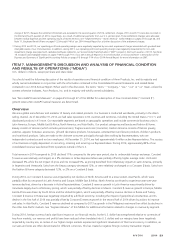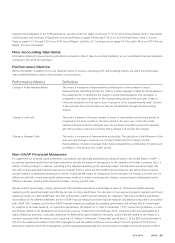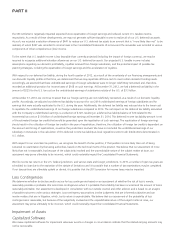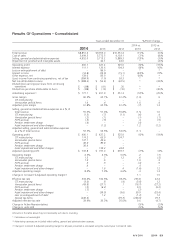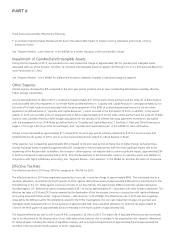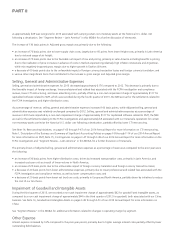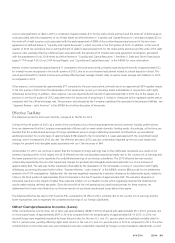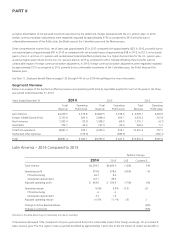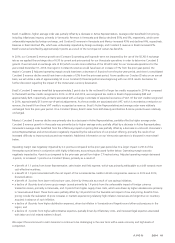Avon 2014 Annual Report Download - page 39
Download and view the complete annual report
Please find page 39 of the 2014 Avon annual report below. You can navigate through the pages in the report by either clicking on the pages listed below, or by using the keyword search tool below to find specific information within the annual report.
In December 2013, we decided to halt further roll-out of our SMT project beyond the pilot market of Canada, in light of the potential risk of
further business disruption. As a result, a non-cash impairment charge for the capitalized software associated with SMT of $117.2 was
recorded. This impairment charge was recorded as a component of our global expenses, within selling, general and administrative expenses
in the Consolidated Statements of Income.
The fair value of the capitalized software associated with SMT (“SMT asset”) was determined using a risk-adjusted discounted cash flow
(“DCF”) model under the relief-from-royalty method. The impairment analysis performed for the asset group, which includes the SMT asset,
required several estimates, including revenue and cash flow projections, and royalty and discount rates. As a result of this impairment
charge, the remaining carrying amount of the SMT asset is not material.
See Note 1, Description of the Business and Summary of Significant Accounting Policies on pages F-8 through F-14 of our 2014 Annual
Report for more information on SMT.
Goodwill and Intangible Assets
We test goodwill and intangible assets with indefinite lives for impairment annually, and more frequently if circumstances warrant, using
various fair value methods. We review finite-lived intangible assets, which are subject to amortization, for impairment whenever events or
changes in circumstances indicate that the related carrying amounts may not be recoverable.
We completed our annual goodwill impairment assessment for 2014 and determined that the estimated fair values were considered
substantially in excess of the carrying values of each of our reporting units.
The impairment analyses performed for goodwill and intangible assets require several estimates in computing the estimated fair value of a
reporting unit, an indefinite-lived intangible asset, and a finite-lived intangible asset. As part of our goodwill impairment analysis, we
typically use a DCF approach to estimate the fair value of a reporting unit, which we believe is the most reliable indicator of fair value of a
business, and is most consistent with the approach that we would generally expect a market participant would use. In estimating the fair
value of our reporting units utilizing a DCF approach, we typically forecast revenue and the resulting cash flows for periods of five to ten
years and include an estimated terminal value at the end of the forecasted period. When determining the appropriate forecast period for the
DCF approach, we consider the amount of time required before the reporting unit achieves what we consider a normalized, sustainable level
of cash flows. The estimation of fair value utilizing a DCF approach includes numerous uncertainties which require significant judgment
when making assumptions of expected growth rates and the selection of discount rates, as well as assumptions regarding general economic
and business conditions, and the structure that would yield the highest economic value, among other factors.
China
During the third quarter of 2012, we completed an interim impairment assessment of the fair value of goodwill related to our operations in
China, based on the continued decline in revenue performance in and a corresponding lowering of our long-term growth estimates in that
market. We made changes to our long-term growth estimates as the China business did not achieve our revenue, earnings and cash flows
expectations primarily due to challenges in our business model. As a result of our impairment testing, we recorded a non-cash impairment
charge of $44.0 in the third quarter of 2012 to reduce the carrying amount of goodwill to its estimated fair value.
As compared to our projections used in our fourth quarter 2012 impairment analysis (“Q4 2012 projections”), China performed generally in
line with our revenue and earnings projections during the first half of 2013. As assumed in our Q4 2012 projections, China’s revenue in the
first half of 2013 continued to deteriorate versus the prior-year period; however, beginning in the third quarter of 2013, this revenue decline
was significantly in excess of our assumptions. As a result, in the third quarter of 2013, it became apparent that we would not achieve our
2013 and long-term forecasted revenue and earnings, and we completed an interim impairment assessment of the fair value of goodwill
related to our operations in China. The revenue decline in China during the third quarter of 2013 resulted in the recognition of an operating
loss while we had expected operating profit in our Q4 2012 projections. In the third quarter of 2013, we significantly lowered our long-term
revenue and earnings projections for China that was included in our DCF model utilized in our interim impairment assessment. As a result of
our impairment testing, we recorded a non-cash impairment charge of $42.1 in the third quarter of 2013 to reduce the carrying amounts of
goodwill and finite-lived intangible assets. There are no amounts remaining associated with goodwill or intangible assets for our China
reporting unit as a result of this impairment charge.
Key assumptions used in measuring the fair value of China during these impairment assessments included projections of revenue and the
resulting cash flows, as well as the discount rate (based on the estimated weighted-average cost of capital). To estimate the fair value of
A V O N 2014 31




